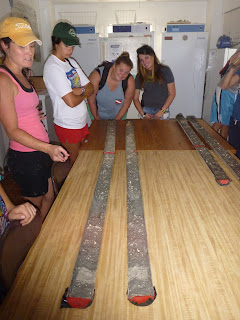We arrived here at Florida Gulf Coast University’s Vester
Marine and Environmental Science Research Field Station on Sunday night. Before
we came I wasn’t too sure what to expect because we hadn’t been given much
information prior to arriving and we were told to get there we had to go
through a condo complex and down a dirt road! I was a little skeptical at first
but after finding it with no trouble I was happily surprised. The research
station here is so cozy and a great environment for learning.
Monday we went out into the estuary and took core sample of
sediments. We went to two separate locations and had to using our brute
strength to drive aluminum cores meters into the ground under water. The cores
had to be cut open and then the puzzle was ready to be solved. By looking at
the differences in the color and composition of the sediment layers we could
predict what the areas where the sediment was collected was like and if any
major storms had passed through. Our instructor estimated our samples could
have been as old as over 2000 years. After staring at dirt for hours I have officially
eliminated an area of study that I DO NOT want to go into. Don’t get me wrong,
I’ll have a hay day playing around in some mud, but to have to study it that closely
for a living, I’ll pass!
Today was just a big day of confusion. We went over physical
oceanography, which included things like the estuary’s currents and circulation.
I learned some interesting things about how freshwater and salt water mix.
Since salt water coming from the ocean in denser it will stay at the bottom of
the water column and have a higher salinity and a lower temperature than the
top of the water where there is freshwater present. We went pretty far up the
Imperial River today and used a YSI and a CTD to measure many different things;
salinity and temperature were the big ones we needed to find the density gradients
in the different locations. We found our hypothesis about the water separation to
be true and discovered the river has a partially mixed residual circulation. We
also measured currents today by dropping grapefruits into the water and
following them for a certain period of time and then calculating their speed.
Unfortunately we got kicked out of our classroom fairly early today so we didn’t
get to discuss all of our findings with our instructor which made things a
little confusing and complicated. After today, I have officially eliminated
another area of study off my list! Hopefully I’ll find something that sparks my
interest a little more by the end of the week, wish me luck!
GO OSPREYS!!




No comments:
Post a Comment